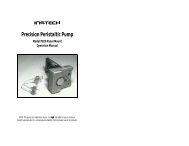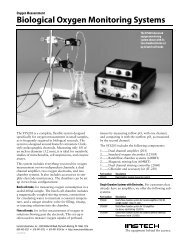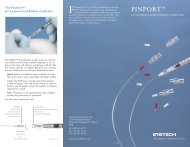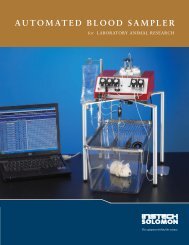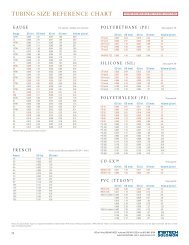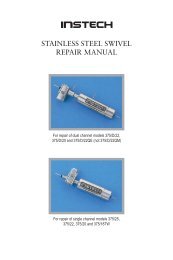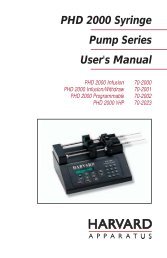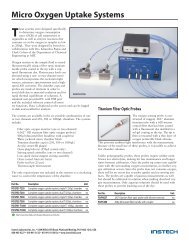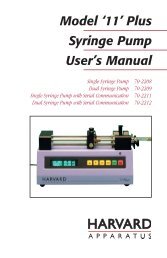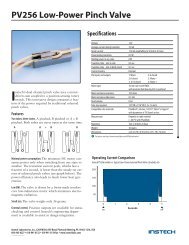110 / 210 Fiber Optic Oxygen Monitor - Instech Laboratories, Inc.
110 / 210 Fiber Optic Oxygen Monitor - Instech Laboratories, Inc.
110 / 210 Fiber Optic Oxygen Monitor - Instech Laboratories, Inc.
Create successful ePaper yourself
Turn your PDF publications into a flip-book with our unique Google optimized e-Paper software.
Appendix 1: Theory of Operation<br />
Linear (Stern-Volmer) Algorithm<br />
The Stern-Volmer algorithm requires at least two<br />
standards of known oxygen concentration. The first<br />
standard must have 0% oxygen concentration and the<br />
last standard must have a concentration in the high<br />
end of the concentration range in which you will be<br />
working. The fluorescence intensity can be expressed<br />
in terms of the Stern-Volmer equation where the<br />
fluorescence is related quantitatively to the partial<br />
pressure of oxygen:<br />
I 0<br />
I<br />
= 1 + k p O2<br />
I 0 is the intensity of fluorescence at zero pressure<br />
of oxygen,<br />
I is the intensity of fluorescence at a pressure p<br />
of oxygen,<br />
k is the Stern-Volmer constant<br />
For a given media, and at a constant total pressure<br />
and temperature, the partial pressure of oxygen is<br />
proportional to oxygen mole fraction.<br />
The Stern-Volmer constant (k) is primarily dependent<br />
on the chemical composition of the ruthenium<br />
complex. Our probes have shown excellent stability<br />
over time, and this value should be largely<br />
independent of the other parts of the measurement<br />
system. However, the Stern-Volmer constant (k) does<br />
vary among probes, and it is temperature dependent.<br />
All measurements should be made at the same<br />
temperature as the calibration experiments or<br />
temperature monitoring devices should be used.<br />
If you decide to compensate for temperature, the<br />
relationship between the Stern-Volmer values and<br />
temperature is defined as:<br />
I 0 = a 0 + b 0 * T + c 0 * T 2<br />
k = a + b * T + c * T 2<br />
The intensity of fluorescence at zero pressure of<br />
oxygen (I 0 ) depends on details of the optical setup:<br />
the power of the LED, the optical fibers, loss of light<br />
at the probe due to fiber coupling, and backscattering<br />
from the sample. It is important to measure the<br />
intensity of fluorescence at zero pressure of oxygen<br />
(I 0 ) for each experimental setup.<br />
It is evident from the equation that the sensor will be<br />
most sensitive to low levels of oxygen. Deviations<br />
from the Stern-Volmer relationship occur primarily at<br />
higher oxygen concentration levels. Using the Second<br />
Order Polynomial algorithm when calibrating<br />
corrects these deviations.<br />
Second Order Polynomial Algorithm<br />
The Second Order Polynomial algorithm requires at<br />
least three standards of known oxygen concentration.<br />
The first standard must have 0% oxygen<br />
concentration and the last standard must have a<br />
concentration in the high end of the concentration<br />
range in which you will be working.<br />
The Second Order Polynomial algorithm is<br />
considered to provide more accurate because it<br />
requires at least three known concentration standards<br />
while the Linear (Stern-Volmer) algorithm requires a<br />
minimum of two known concentration standards. The<br />
Second Order Polynomial algorithm is defined as:<br />
I 0<br />
I<br />
= 1 + K 1 * [O] + K 2 * [O] 2<br />
I 0 is the fluorescence intensity at zero<br />
concentration<br />
I is the intensity of fluorescence at a pressure p<br />
of oxygen,<br />
K 1 is the first coefficient<br />
K 2 is the second coefficient<br />
If you decide to compensate for temperature, the<br />
relationship between the Second Order Polynomial<br />
algorithm and temperature is defined as:<br />
I 0 = a 0 + b 0 * T + c 0 * T 2<br />
K 1 = a 1 + b 1 * T + c 1 * T 2<br />
K 2 = a 2 + b 2 * T + c 2 * T 2<br />
Henry’s Law<br />
It is possible to calibrate the FOXY system in gas and<br />
then use the FOXY system in liquid or vice versa. In<br />
theory, your FOXY system detects the partial<br />
pressure of oxygen. In order to convert partial<br />
pressure to concentration, you can use Henry’s Law.<br />
When the temperature is constant, the weight of a gas<br />
that dissolves in a liquid is proportional to the<br />
pressure exerted by the gas on the liquid. Therefore,<br />
the pressure of the gas above a solution is<br />
proportional to the concentration of the gas in the<br />
28





